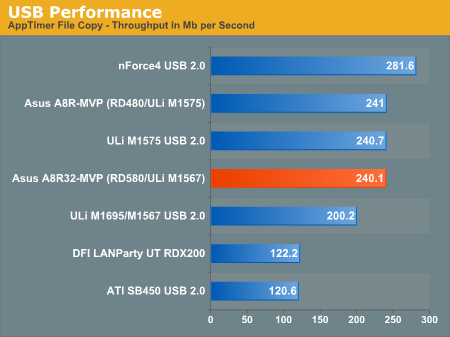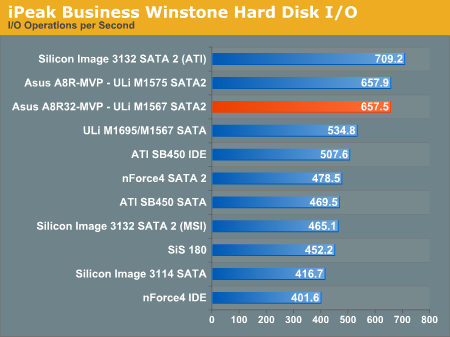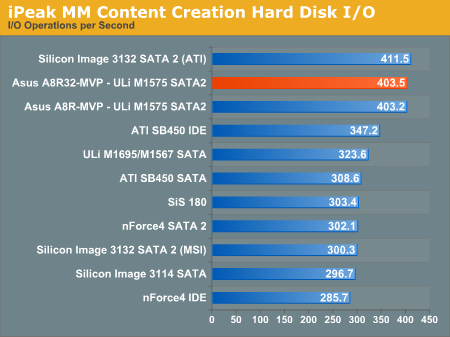Asus A8R32-MVP Deluxe: First ATI RD580
by Wesley Fink on March 1, 2006 9:00 AM EST- Posted in
- Motherboards
USB Performance
USB has been a problem area for the ATI SB450 chipset, but it has not been a major issue with the ULi M1575 southbridge. To test performance of USB on the A8R32-MVP, we ran our standard USB throughput test using an external USB hard drive.
Our test method uses a RAM disk as our “server”, since memory removes almost all overhead from the serving end. We also turn off disk caching on the USB and Firewire side by setting up the drives for “quick disconnect”. Our results are then consistent over many test runs.
We use just 1GB of fast 2-2-2 system memory, set up as a 450MB RAM disk and 550MB of system memory. Our stock file is the SPECviewPerf 8.01 install file, which is 432,533,504 bytes (412.4961MB). After copying this file to our RAM disk, we measure the time for writing from the RAM disk to our external USB 2.0 or Firewire 400 or Firewire 800 drive using a Windows timing program written for AnandTech by our own Jason Clark. The copy times, in seconds, are then converted into Megabits per second (Mb) to provide a convenient means of comparing throughput. Higher Rates therefore mean better performance.
In addition to competitive USB performance, the M1575 also provides the SATA2 ports missing from the ATI SB450. The ULi SATA2 also supports RAID 0, 1, 0+1, 5, and JBOD.
Disk Controller Performance
The AnandTech iPeak test was designed to measure "pure" hard disk performance using the Intel iPeak benchmark. The hard drive is kept as consistent as possible while varying the hard drive controller. The idea is to measure the performance of a hard drive controller with a consistent hard drive.
We played back Anand's raw files that recorded I/O operations when running a real world benchmark - the entire Winstone 2004 suite. Intel's iPEAK utility was then used to play back the trace file of all IO operations that took place during a single run of Business Winstone 2004 and MCC Winstone 2004. The drive was formatted before each test run and a composite average of 5 tests on each controller interface was tabulated in order to ensure consistency in the benchmark.
iPeak gives a mean service time in milliseconds; in other words, the average time that each drive took to fulfill each IO operation. In order to make the data more understandable, we report the scores as an average number of IO operations per second so that higher scores translate into better performance. This number is meaningless as far as hard disk performance is concerned as it is just the number of IO operations completed in a second. However, the scores are useful for comparing "pure" performance of the storage controllers in this case.
USB has been a problem area for the ATI SB450 chipset, but it has not been a major issue with the ULi M1575 southbridge. To test performance of USB on the A8R32-MVP, we ran our standard USB throughput test using an external USB hard drive.
Our test method uses a RAM disk as our “server”, since memory removes almost all overhead from the serving end. We also turn off disk caching on the USB and Firewire side by setting up the drives for “quick disconnect”. Our results are then consistent over many test runs.
We use just 1GB of fast 2-2-2 system memory, set up as a 450MB RAM disk and 550MB of system memory. Our stock file is the SPECviewPerf 8.01 install file, which is 432,533,504 bytes (412.4961MB). After copying this file to our RAM disk, we measure the time for writing from the RAM disk to our external USB 2.0 or Firewire 400 or Firewire 800 drive using a Windows timing program written for AnandTech by our own Jason Clark. The copy times, in seconds, are then converted into Megabits per second (Mb) to provide a convenient means of comparing throughput. Higher Rates therefore mean better performance.

In addition to competitive USB performance, the M1575 also provides the SATA2 ports missing from the ATI SB450. The ULi SATA2 also supports RAID 0, 1, 0+1, 5, and JBOD.
Disk Controller Performance
The AnandTech iPeak test was designed to measure "pure" hard disk performance using the Intel iPeak benchmark. The hard drive is kept as consistent as possible while varying the hard drive controller. The idea is to measure the performance of a hard drive controller with a consistent hard drive.
We played back Anand's raw files that recorded I/O operations when running a real world benchmark - the entire Winstone 2004 suite. Intel's iPEAK utility was then used to play back the trace file of all IO operations that took place during a single run of Business Winstone 2004 and MCC Winstone 2004. The drive was formatted before each test run and a composite average of 5 tests on each controller interface was tabulated in order to ensure consistency in the benchmark.
iPeak gives a mean service time in milliseconds; in other words, the average time that each drive took to fulfill each IO operation. In order to make the data more understandable, we report the scores as an average number of IO operations per second so that higher scores translate into better performance. This number is meaningless as far as hard disk performance is concerned as it is just the number of IO operations completed in a second. However, the scores are useful for comparing "pure" performance of the storage controllers in this case.












65 Comments
View All Comments
superkdogg - Wednesday, March 1, 2006 - link
If you had been working for half the time you have been whining on every forum you can find, you could have bought two SLI-Experts or whatever motherboard you think has no problems.Dude, get over it. The A8R was not exactly as reviewed here. Is that disappointing? Yep. Unfair? Maybe. Fact is, anybody who bought it for the "serious overclocking" that you're referencing would do a vMod and get on with it. I have two A8R's. One is dead because I was stupid and tried a vMod. My soldering needs work. I bought a second one on refurb for $75 because I realized that in the best case, that vMod might get me another 150 MHz. You know what else would get me 150 MHz? Dusting off a Pentium Pro in my basement. I could also get the 2% benefit that 1T timing would give me from chance, since most 'marks are + or - 2-3%.
I was burned by the same problem you were. I have learned to live with it and am currently happily running 300x9 with ram @ 2.5-4-4-9, 2T (166/200). That's not bad for standard blue heatspreader Patriot that runs about $80 per gig.
DigitalFreak - Wednesday, March 1, 2006 - link
Omid, is that you?yacoub - Sunday, February 19, 2006 - link
Should have run the 3DMark benches with the 7800GTX like all the other boards so at least we could see if the board itself (the object of review) offered any particular performance gain or loss. :[yacoub - Sunday, February 19, 2006 - link
oic now, thanks. :)green bars. tricksy hobbitses!
Missing Ghost - Sunday, February 19, 2006 - link
I am unhappy with the pictures of the board included in this review. I can't see anything on them because they are too dark. I couldn't even tell if they were a firewire port on the back.Wesley Fink - Wednesday, March 1, 2006 - link
The pictures are not overly dark on several monitors we tried in reading the review. I'm sorry I don't have advice in that area.As stated in the review, both Firewire ports are on an accesory bracket included with the motherboard. The bracket will fit in an empty slot or can be routed to case firewire ports.
Googer - Sunday, February 19, 2006 - link
What Phase Power is this motherboard using? 2,3,4,8,24?Beenthere - Sunday, February 19, 2006 - link
Any properly designed 3-phase or greater CPU vcore circuit that complies with AMD's VRM64/T specs will work just fine. If however a mfg. delivers a poor circuit design or uses inferior MOSFETS, caps, etc., then you experience Vcore instability which causes all kinds of operational Hell. More phases just lowers the ripple and spreads the load across more MOSFETS.Beenthere - Sunday, February 19, 2006 - link
BTW, if you check the A8R-MVP, the A8N series and the Asus P5GL-MX you'll see that all of these mobos have been confirmed to have vcore instability problems when tested at the mobo with a DVM or scope. Asus seems to have some significant mobo engineering issues they can't resolve... and that are not present on other brands of mobos using the same chipsets.Ecmaster76 - Sunday, February 19, 2006 - link
Do you work for DFI or Abit or something? This is the third site where I have ran into you flaming Asus constantly!(where did I put that troll repellant)
Seriously, link some proof of said Vcore instability. Show me scope printouts of the Vcore lines (and the 12v rails that were used to drive it)